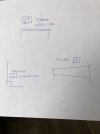- Joined
- Jul 17, 2019
- Messages
- 324
I've been having real trouble making handle blocks square and flat, despite the fact that I've got a good variable speed Ameribrade grinder and a (non-variable speed) disc grinder. I had thought the problem was that I was putting uneven pressure on the material when grinding it, but even when I basically just let the block rest lightly on the belt it doesn't quite come out flat.
It's a problem because I'm trying to thin out and flatten non-metal frames for frame handles, and if they don't come out flat the scales won't be flush with the frame. If it were just flattening I could use a piece of plate glass and some sandpaper, but the thinnest I can slice material for frames is about 3/16" and I usually need to take them down to around .09". Any advice would be very much appreciated.
It's a problem because I'm trying to thin out and flatten non-metal frames for frame handles, and if they don't come out flat the scales won't be flush with the frame. If it were just flattening I could use a piece of plate glass and some sandpaper, but the thinnest I can slice material for frames is about 3/16" and I usually need to take them down to around .09". Any advice would be very much appreciated.
Last edited:



